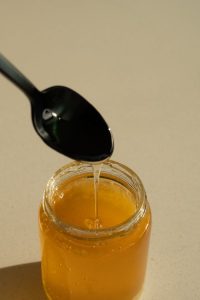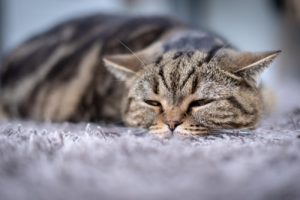Hypoglycaemia in cats means having low blood sugar. The risk of hypoglycaemia is greatest in very young, thin or small cats. And also in diabetic cats having insulin treatment. Symptoms of hypoglycaemia can range from mild to life-threatening.
Blood glucose (sugar) provides the energy to fuel essential body functions. Hypoglycaemia symptoms happen when organs that need lots of fuel don’t get enough to work. Hypoglycaemia is potentially life-threatening. It comes on quickly and can rapidly worsen. So always call a vet if you think your cat has hypoglycaemia.
What to do
What to do if you think your cat has hypoglycaemia
If you think your cat has hypoglycaemia, give them an immediate sugar boost then call a vet without delay.
Emergency first aid for hypoglycemia in cats
- Rub something sweet or sugary onto your cat’s mouth and tongue or cheeks. Honey, sugary water or jam are good options.
- Call a vet without delay for an emergency appointment
- Continue with first aid measures until you see the vet
- Keep your cat warm until they see the vet

Look for an underlying cause or trigger
- Call a vet immediately if you think you have given your diabetic cat too much insulin.
- Check whether your cat may have eaten something containing artificial sweeteners and always tell the vet if this is a possibility
- Speak to a vet as soon as possible if your cat vomits food after having their normal insulin injection.
The most common warning signs of hypoglycaemia
- Becoming very tired/having no energy
- Looking vacant or spaced-out
- Being wobbly on their legs
- Vomiting
- Trembling, muscle twitching and weakness
- Fainting and collapse
- Having seizures (fits)
Always call a vet if you think your cat may be hypoglycaemic. Even where symptoms seem ‘mild’. Things can change very quickly.

- Lethargy is a sign of hypoglycaemia in cats
Causes
Common causes of hypoglycaemia in cats
The most common causes of hypoglycaemia in cats include:
- Getting too much insulin treatment for diabetes
- Kittens and very small cats exhausting their limited energy stores if cold or unfed
- Kittens having lots of intestinal worms
- Poisoning with Xylitol, an artificial sweetener present in some human foods
- Being starved or malnourished on an unsuitable diet
- Severe infections
- Having severe liver disease, a liver shunt or pancreatitis
- Developing an insulinoma: a growth producing too much insulin
- Having cancer
When to worry
When to worry about hypoglycaemia in cats
Contact your nearest vet immediately if your cat is:
- Confused or staggering
- Having a seizure
- Collapsed or not responding to you
If you have overdosed your diabetic cat’s insulin treatment, contact a vet immediately.
Joii can help with advice on:
- Recognising signs of hypoglycaemia
- Treating hypoglycaemia until you see an in-person vet
- Understanding the risks of hypoglycaemia
Prevention
Tips on how to prevent hypoglycaemia in cats
Some causes of hypoglycaemia may be preventable. This includes hypoglycaemia affecting diabetic cats, neonates or thin cats.
Diabetic cats:
- Measure insulin doses carefully if using an insulin syringe and needle. Preset insulin pens are safer options, but more expensive
- Learn as much as possible about how and when your cat needs insulin or extra fuel
- Avoid sudden exercise extremes or dramatic changes in daily activity
Non-diabetic cats:
- Keep kittens warm at all times – shivering burns a lot of energy!
- Use regular worming treatments
- Ensure all kittens get a chance to suck as soon as possible after birth. Hypoglycaemia can set in within 1-2 hours of missing a feed.
- Keep chewing gum, medicines and ‘low sugar’ varieties of human food (which contain artificial sweetener) out of sight and reach of cats
- Ensure your cat gets a complete and well-balanced cat food diet suitable for their age, lifestyle and general health.
- Recognise and treat other illnesses promptly
Sometimes there may be no prior warning or apparent risk of your cat becoming hypoglycaemic. In these cases, prevention won’t be possible until the cause is diagnosed. This includes insulinoma and some cancers.
Home treatment
How can I help my cat at home if they’re hypoglycaemic?
Hypoglycaemia can rapidly become life-threatening. Always call a vet if you see the warning signs.
Even before you do call a vet, giving first aid for hypoglycaemia is essential. Emergency first aid means raising blood glucose levels quickly.
- Best achieved with the simplest, most concentrated forms of sugar: sugary water, honey and jam are ideal.
If your cat’s symptoms are mild and they can swallow normally:
- Give sugary water drinks: dissolve a tablespoon of sugar in a tumbler of water
- Offer honey or maple syrup: 1-2 teaspoons for cats
- Keep your cat warm until they see the vet.
Vet treatment
Vet treatment for hypoglycaemia in cats
Vet treatment for hypoglycaemia will have 3 phases:
Phase 1
Emergency treatment to raise blood sugar levels and restore ‘energy supply’ to vital organs
- Giving fluids containing glucose directly into a vein in your cat’s leg
Specialist emergency treatment for severe hypoglycaemia
- Injections of a hormone called glucagon. Glucagon acts in the opposite way to insulin. It increases blood glucose.
Part 2
Finding out why the episode occurred:
- Taking a history
- Physical examination
- Blood tests: general health and blood glucose curve
Depending on the findings, other tests may include:
- X-rays, ultrasound scan, CT scan.
Part 3
Treating the underlying cause:
- Adjusting insulin treatment
- Lifestyle advice
- Treating specific causes like liver disease or pancreatitis
Risk
Cats with a higher risk of hypoglycaemia
Some cats are more likely to develop hypoglycaemia than others. Reasons for this include:
- Diabetic cats: depending on injections of insulin risk accidental overdose, or not keeping down enough food after an injection
- Newborn and very young kittens, very small thin cats: few fat or muscle stores for energy; poor ability to cope with stressors, like getting cold or hungry or having worms.
- Certain breeds: hairless, ‘thin-skinned’ and sparsely-haired cat breeds, such as Sphynx and Bambino.
- Cats who go outdoors and who hunt are more likely to encounter poisons.
- Older cats: more susceptible to liver disease, cancer and other illnesses.
- Cats with other illnesses: liver disease, chronic kidney disease, FIV, FeLV.
Other causes
- Pregnancy: particularly unplanned and undetected pregnancies. Mum puts all her energy into the growing kittens inside her
- Addison’s disease: cats without enough cortisol struggle to manage glucose levels when they’re stressed.
- Heat stroke








